Study on Stress Testing and the Evaluation of Flood Resilience in Mountain Communities
Abstract
1. Introduction
2. Materials
2.1. Overview of the Study Area
2.2. Digital Elevation Model
2.3. Land Use Data
2.4. Rainfall and Water Depth Data
3. Methodology
3.1. Stress Test
3.2. Scenarios for Rainfall
3.3. Hydrodynamic Model
3.4. Model Validation
3.5. Resilience Assessment
4. Case Study
4.1. Parameter Rate Setting and Model Validation
4.2. Stress Test Results
4.2.1. Effect of Rainfall Duration on Inundation Characteristics
- (1)
- Short-Duration Rainfall Response Characteristics:
- (2)
- Long-Duration Rainfall Response Characteristics:
4.2.2. Relationship Between Rainfall Intensity and Inundation Depth
4.2.3. Diversionary Effects of Roads
4.2.4. Depth–Flow Velocity Coupling Effects
4.3. Risk Spot Analysis
4.4. Resilience Assessment
5. Conclusions
Author Contributions
Funding
Institutional Review Board Statement
Informed Consent Statement
Data Availability Statement
Conflicts of Interest
References
- Calel, R.; Stainforth, D.A. Little floods everywhere: What will climate change mean for you? Clim. Change 2024, 178, 1. [Google Scholar] [CrossRef]
- Dharmarathne, G.; Waduge, A.O.; Bogahawaththa, M.; Rathnayake, U.; Meddage, D.P.P. Adapting cities to the surge: A comprehensive review of climate-induced urban flooding. Results Eng. 2024, 22, 102123. [Google Scholar] [CrossRef]
- Sun, H.; Krysanova, V.; Gong, Y.; Gao, M.; Treu, S.; Chen, Z.; Jiang, T. The recent trends of runoff in China attributable to climate change. Clim. Change 2024, 177, 159. [Google Scholar] [CrossRef]
- Ripple, W.J.; Wolf, C.; Gregg, J.W.; Rockström, J.; Newsome, T.M.; Law, B.E.; Marques, L.; Lenton, T.M.; Xu, C.; Huq, S.; et al. The 2023 state of the climate report: Entering uncharted territory. BioScience 2023, 73, 841–850. [Google Scholar] [CrossRef]
- Borga, M.; Anagnostou, E.N.; Blöschl, G.; Creutin, J.D. Flash flood forecasting, warning and risk management: The HYDRATE project. Environ. Sci. Policy 2011, 14, 834–844. [Google Scholar] [CrossRef]
- Gourley, J.J.; Flamig, Z.L.; Vergara, H.; Kirstetter, P.-E.; Clark, R.A.; Argyle, E.; Arthur, A.; Martinaitis, S.; Terti, G.; Erlingis, J.M.; et al. The FLASH Project: Improving the Tools for Flash Flood Monitoring and Prediction across the United States. Bull. Am. Meteorol. Soc. 2017, 98, 361–372. [Google Scholar] [CrossRef]
- Lee, H.; Calvin, K.; Dasgupta, D.; Krinner, G.; Mukherji, A.; Thorne, P.; Trisos, C.; Romero, J.; Aldunce, P.; Barrett, K.; et al. Contribution of Working Groups I, II and III to the Sixth Assessment Report of the Intergovernmental Panel on Climate Change. In Climate Change 2023: Synthesis Report; IPCC: Geneva, Switzerland, 2023; Volume 50, pp. 35–115. [Google Scholar] [CrossRef]
- Holling, C.S. Resilience and Stability of Ecological Systems. Annu. Rev. Ecol. Evol. Syst. 1973, 4, 1–23. [Google Scholar] [CrossRef]
- Allen, C.R.; Angeler, D.G.; Cumming, G.S.; Folke, C.; Twidwell, D.; Uden, D.R. Quantifying spatial resilience. J. Appl. Ecol. 2016, 53, 625–635. [Google Scholar] [CrossRef]
- Ahmed, S.; Dey, K. Resilience modeling concepts in transportation systems: A comprehensive review based on mode, and modeling techniques. J. Infrastruct. Preserv. Resil. 2020, 1, 8. [Google Scholar] [CrossRef]
- He, R.; Tiong, R.L.K.; Yuan, Y.; Zhang, L. Enhancing resilience of urban underground space under floods: Current status and future directions. Tunn. Undergr. Space Technol. 2024, 147, 105674. [Google Scholar] [CrossRef]
- Huang, W.; Cao, Z.-X.; Qi, W.-J.; Pender, G.; Zhao, K. Full 2D hydrodynamic modelling of rainfall-induced flash floods. J. Mt. Sci. 2015, 12, 1203–1218. [Google Scholar] [CrossRef]
- Fernandez-Novoa, D.; Gonzalez-Cao, J.; Garcia-Feal, O. Enhancing Flood Risk Management: A Comprehensive Review on Flood Early Warning Systems with Emphasis on Numerical Modeling. Water 2024, 16, 1408. [Google Scholar] [CrossRef]
- Prasanchum, H.; Pimput, Y. Risk assessment of flash flood situation under land use change using daily SWAT streamflow simulation in Loei Basin, Northeastern, Thailand. IOP Conf. Ser. Earth Environ. Sci. 2023, 1151, 012015. [Google Scholar] [CrossRef]
- Abdel-Mooty, M.N.; El-Dakhakhni, W.; Coulibaly, P. Data-Driven Community Flood Resilience Prediction. Water 2022, 14, 2120. [Google Scholar] [CrossRef]
- Madi, H.; Bedjaoui, A.; Elhoussaoui, A.; Elbakai, L.O.; Bounaama, A. Flood Vulnerability Mapping and Risk Assessment Using Hydraulic Modeling and GIS in the Tamanrasset Valley Watershed, Algeria. J. Ecol. Eng. 2023, 24, 35–48. [Google Scholar] [CrossRef] [PubMed]
- Sajjad, A.; Lu, J.; Chen, X.; Yousaf, S.; Mazhar, N.; Shuja, S. Flood hazard assessment in Chenab River basin using hydraulic simulation modeling and remote sensing. Nat. Hazards 2024, 120, 7679–7700. [Google Scholar] [CrossRef]
- Zhang, J.; Wang, H.; Huang, J.; Sun, D.; Liu, G. Evaluation of Urban Flood Resilience Enhancement Strategies—A Case Study in Jingdezhen City under 20-Year Return Period Precipitation Scenario. ISPRS Int. J. Geo-Inf. 2022, 11, 285. [Google Scholar] [CrossRef]
- Wang, K.; Chen, J.; Hu, H.; Tang, Y.; Huang, J.; Wu, Y.; Lu, J.; Zhou, J. Urban Waterlogging Simulation and Disaster Risk Analysis Using InfoWorks Integrated Catchment Management: A Case Study from the Yushan Lake Area of Ma’anshan City in China. Water 2024, 16, 3383. [Google Scholar] [CrossRef]
- Wei, H.; Wu, H.; Zhang, L.; Liu, J. Urban flooding simulation and flood risk assessment based on the InfoWorks ICM model: A case study of the urban inland rivers in Zhengzhou, China. Water Sci. Technol. 2024, 90, 1338–1358. [Google Scholar] [CrossRef]
- Wei, H.; Zhang, L.; Liu, J. Hydrodynamic Modelling and Flood Risk Analysis of Urban Catchments under Multiple Scenarios: A Case Study of Dongfeng Canal District, Zhengzhou. Int. J. Environ. Res. Public Health 2022, 19, 14630. [Google Scholar] [CrossRef] [PubMed]
- Schelfaut, K.; Pannemans, B.; van der Craats, I.; Krywkow, J.; Mysiak, J.; Cools, J. Bringing flood resilience into practice: The FREEMAN project. Environ. Sci. Policy 2011, 14, 825–833. [Google Scholar] [CrossRef]
- Aerts, J.C.J.H.; Botzen, W.J.W.; Emanuel, K.; Lin, N.; de Moel, H.; Michel-Kerjan, E.O. Evaluating Flood Resilience Strategies for Coastal Megacities. Science 2014, 344, 473–475. [Google Scholar] [CrossRef]
- Melendez, A.; Gutierrez Soto, M. Flood Resilience Quantification Framework of Rural Communities: Case Study of Harlan County, Kentucky. Nat. Hazards Rev. 2024, 25, 05024009. [Google Scholar] [CrossRef]
- Dewa, O.; Makoka, D.; Ayo-Yusuf, O.A. Measuring community flood resilience and associated factors in rural Malawi. J. Flood Risk Manag. 2023, 16, e12874. [Google Scholar] [CrossRef]
- Rameli, N.L.; Majid, N.A.; Mohamed, A.F. Assessing Community Resilience to Flood Disasters: A Case Study of Temerloh, Pahang. Geographies 2024, 4, 583–595. [Google Scholar] [CrossRef]
- Xu, W.; Zhong, M.; Hong, Y.; Lin, K. Enhancing community resilience to urban floods with a network structuring model. Saf. Sci. 2020, 127, 104699. [Google Scholar] [CrossRef]
- Yuan, F.; Fan, C.; Farahmand, H.; Coleman, N.; Esmalian, A.; Lee, C.-C.; Patrascu, F.I.; Zhang, C.; Dong, S.; Mostafavi, A. Smart flood resilience: Harnessing community-scale big data for predictive flood risk monitoring, rapid impact assessment, and situational awareness. Environ. Res. Infrastruct. Sustain. 2022, 2, 025006. [Google Scholar] [CrossRef]
- Merton, R.C. On The Pricing of Corporate Debt: The Risk Structure of Interest Rates. J. Financ. 1974, 29, 449–470. [Google Scholar] [CrossRef]
- Wilson, T.C. Portfolio Credit Risk. Econ. Policy Rev. 1998, 4, 71–82. Available online: https://EconPapers.repec.org/RePEc:fip:fednep:y:1998:i:oct:p:71-82:n:v.4no.3 (accessed on 6 June 2025). [CrossRef]
- Venkateswaran, V.B.; Saini, D.K.; Sharma, M. Techno-economic hardening strategies to enhance distribution system resilience against earthquake. Reliab. Eng. Syst. Saf. 2021, 213, 107682. [Google Scholar] [CrossRef]
- Liu, W.; Song, Z. Review of studies on the resilience of urban critical infrastructure networks. Reliab. Eng. Syst. Saf. 2020, 193, 106617. [Google Scholar] [CrossRef]
- Moradi-Sepahvand, M.; Amraee, T.; Gougheri, S.S. Deep Learning Based Hurricane Resilient Coplanning of Transmission Lines, Battery Energy Storages, and Wind Farms. IEEE Trans. Ind. Inform. 2022, 18, 2120–2131. [Google Scholar] [CrossRef]
- Nasri, A.; Abdollahi, A.; Rashidinejad, M. Multi-stage and resilience-based distribution network expansion planning against hurricanes based on vulnerability and resiliency metrics. Int. J. Electr. Power Energy Syst. 2022, 136, 107640. [Google Scholar] [CrossRef]
- Jiao, Z.; Zhang, Z.; Wu, L. SAR-based dynamic information retrieving of the Beijing-Tianjin-Hebei flood-inundation happened in July 2023, North China. Geomat. Nat. Hazards Risk 2024, 15, 2366361. [Google Scholar] [CrossRef]
- ASF, NASA. ALOS PALSAR Radiometric Terrain Corrected Low Res; Includes Material ©JAXA/METI 2007; ASF, NASA: Fairbanks, AK, USA, 2015; Available online: https://docs.asf.alaska.edu/datasets/palsar/ (accessed on 6 June 2025).
- FAO; IIASA. Harmonized World Soil Database Version 2.0; FAO: Rome, Italy; IIASA: Laxenburg, Austria, 2023; 69p. [Google Scholar] [CrossRef]
- Li, Z.; Zhang, H.; Lu, F.; Xue, R.; Yang, G.; Zhang, L. Breaking the resolution barrier: A low-to-high network for large-scale high-resolution land-cover mapping using low-resolution labels. ISPRS J. Photogramm. Remote Sens. 2022, 192, 244–267. [Google Scholar] [CrossRef]
- Che, Y.; Li, X.; Liu, X.; Wang, Y.; Liao, W.; Zheng, X.; Zhang, X.; Xu, X.; Shi, Q.; Zhu, J.; et al. 3D-GloBFP: The first global three-dimensional building footprint dataset. Earth Syst. Sci. Data 2024, 16, 5357–5374. [Google Scholar] [CrossRef]
- China National Institute of Standardization. Specifications for Siting and Installation of Automatic Weather Station. 2022. Available online: https://www.cma.gov.cn/zfxxgk/gknr/flfgbz/bz/202209/t20220921_5098939.html (accessed on 6 June 2025).
- Berkowitz, J. A Coherent Framework for Stress-Testing; Finance and Economics Discussion Series (Topic); Board of Governors: Washington, DC, USA, 1999; pp. 5–15. [Google Scholar] [CrossRef]
- Kupiec, P.H. The New Basel Capital Accord: The Devil Is in the (Calibration) Details. IMF Work. Pap. 2001, 2001, A001. [Google Scholar] [CrossRef]
- Aydin, N.Y.; Duzgun, H.S.; Wenzel, F.; Heinimann, H.R. Integration of stress testing with graph theory to assess the resilience of urban road networks under seismic hazards. Nat. Hazards 2018, 91, 37–68. [Google Scholar] [CrossRef]
- Ma, Z.; Nie, S.; Liao, H. A load spectra design method for multi-stress accelerated testing. Proc. Inst. Mech. Eng. Part O J. Risk Reliab. 2021, 236, 1748006X2110620. [Google Scholar] [CrossRef]
- Chen, J.; Li, Y.; Zhang, C. The Effect of Design Rainfall Patterns on Urban Flooding Based on the Chicago Method. Int. J. Environ. Res. Public Health 2023, 20, 4245. [Google Scholar] [CrossRef]
- Beijing Municipal Commission of Urban Planning. Standard of Rainstorm Runoff Calculation for Urban Storm Drainage System Planning and Design. 2016. Available online: https://std.samr.gov.cn/db/search/stdDBDetailed?id=91D99E4D5F622E24E05397BE0A0A3A10 (accessed on 6 June 2025).
- Dai, X.; Huang, H.; Yu, F.; Wu, A.; Shi, D.; Zhang, P. Research on community resilience stress testing method under rainstorm waterlogging disaster. J. Tsinghua Univ. (Sci. Technol.) 2024, 64, 1587–1596. [Google Scholar] [CrossRef]
- Keifer, C.J.; Chu, H.H. Synthetic storm pattern for drainage design. J. Hydraul. Div. 1957, 83, 1325–1332. [Google Scholar] [CrossRef]
- Liao, D.; Zhu, H.; Zhou, J.; Wang, Y.; Sun, J. Study of the natural rainstorm moving regularity method for hyetograph design. Theor. Appl. Climatol. 2019, 138, 1311–1321. [Google Scholar] [CrossRef]
- Wang, L.; Pan, X.; Zhao, F.; Yang, S.; Li, Y.; Li, H.; Liu, Z.; Xu, M. Compilation and Application of Urban Waterlogging Risk Map in Beijing; Beijing Waterworks: Beijing, China, 2022; pp. 24–29+43. [Google Scholar] [CrossRef]
- Shen, M. During and After the Disaster! Multi-Image Comparison of Mentougou’s Recovery and Reconstruction. 2023. Available online: https://www.toutiao.com/article/7292271587213050406/ (accessed on 6 June 2025).
- Yang, L.; Ren, M. Mobile Communication Interrupted in 5 Towns of Mentougou District, Beijing; Power Supply Cut off in Some Areas–Emergency Repair Work Underway. 2023. Available online: https://www.toutiao.com/article/7262135087389753908/ (accessed on 6 June 2025).
- Xiangyu, H.; Tianqi, W.; Jun, C. Two Men Trekked 8 Hours Out of the Mountains and Guided Rescue Teams to Save 6 Stranded Villages: “I Just Did What I Should”. 2023. Available online: https://www.toutiao.com/article/7264567427269132835/ (accessed on 6 June 2025).
- Wang, Y.; Zhang, K.; Li, Z.; Tong, Y.; Di, S.; Zheng, F.; Li, Q. Identification and Analysis of Flood Submersion Range of the "23·7" Extreme Rainstorm in Beijing; Beijing Waterworks: Beijing, China, 2024; pp. 5–11. [Google Scholar] [CrossRef]
- Zhang, Y.; He, S.; Ma, J.; Sun, S.; Wang, Z.; Wu, J. Simulation of Flash Floods in Urban Small Watersheds Based on 1D and 2D Coupled Hydrodynamic Methods: A Case Study of the “23·7” Rainstorm Flash Flood in Mentougou, Beijing. South-to-North Water Transf. Water Sci. Technol. (Chin. Engl.) 2025, 23, 590–597. [Google Scholar] [CrossRef]
- Wang, Y.; Du, L.; Ji, M.; Gao, Q.; Zhang, X.; Liang, S.; Wang, M.; Han, C. Analysis of New Runoff Generation Mechanism of the “23·7” Extreme Flood in Yongding River Basin, Beijing. China Flood Drought Manag. 2025. [Google Scholar] [CrossRef]
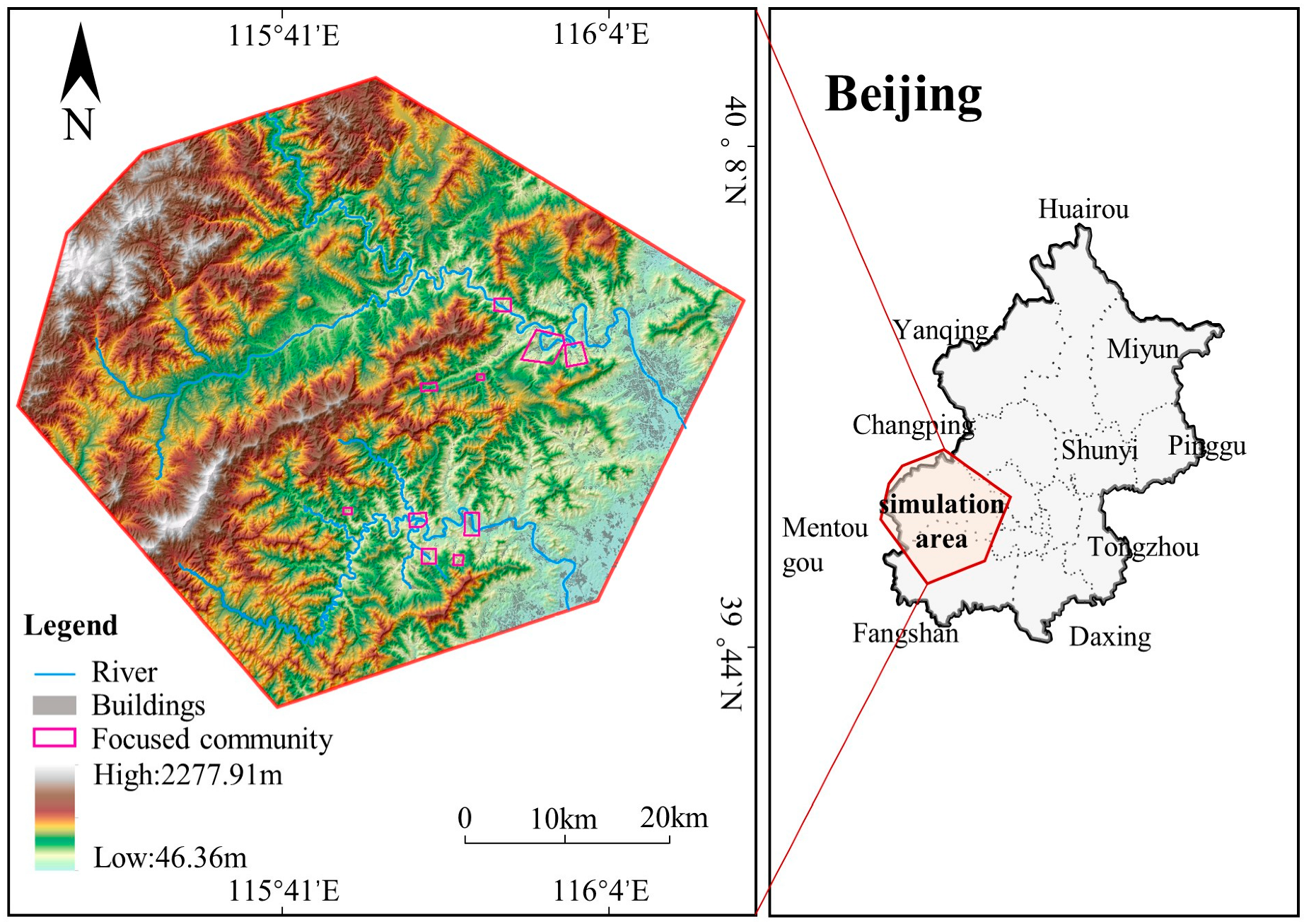
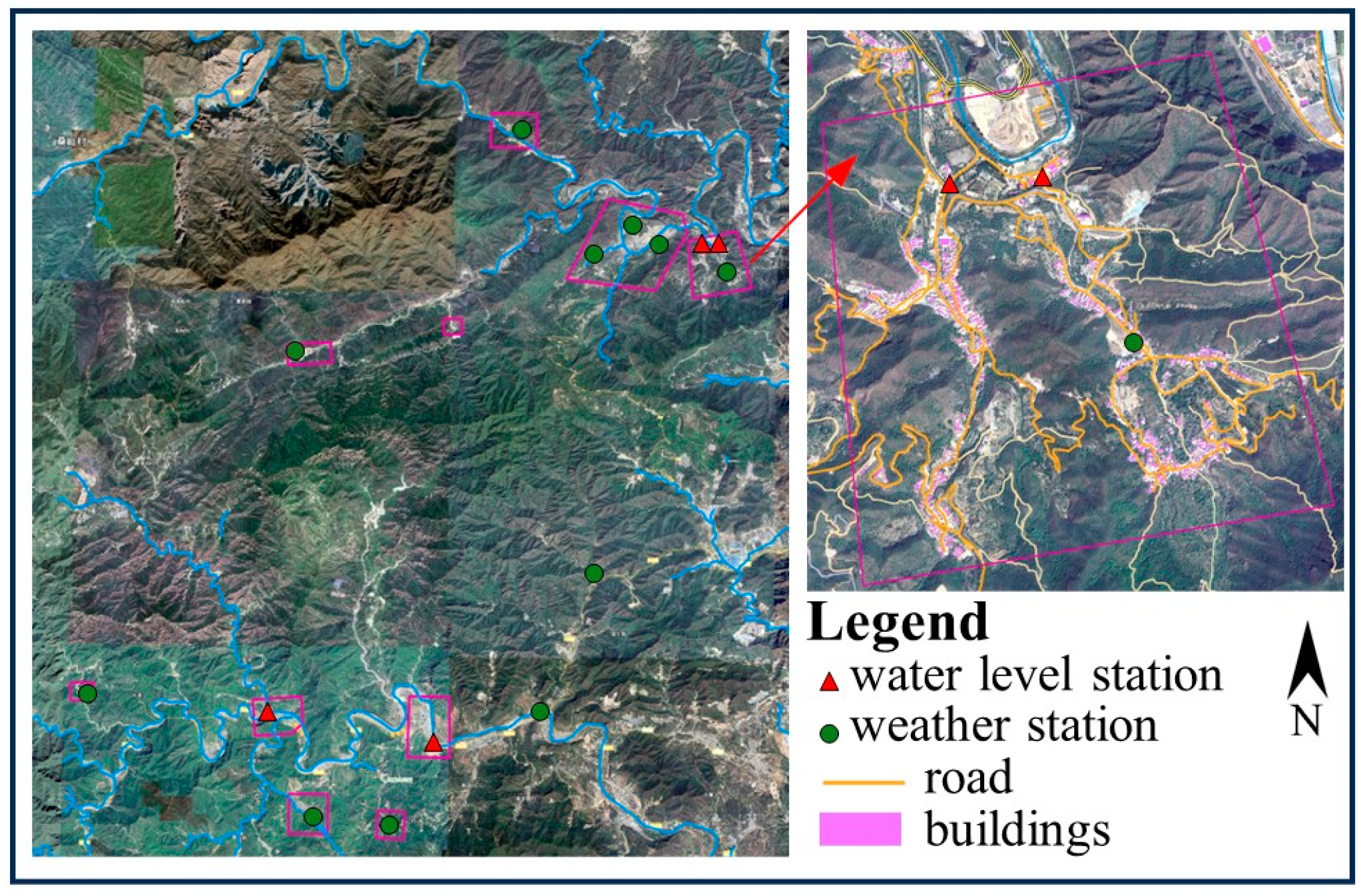
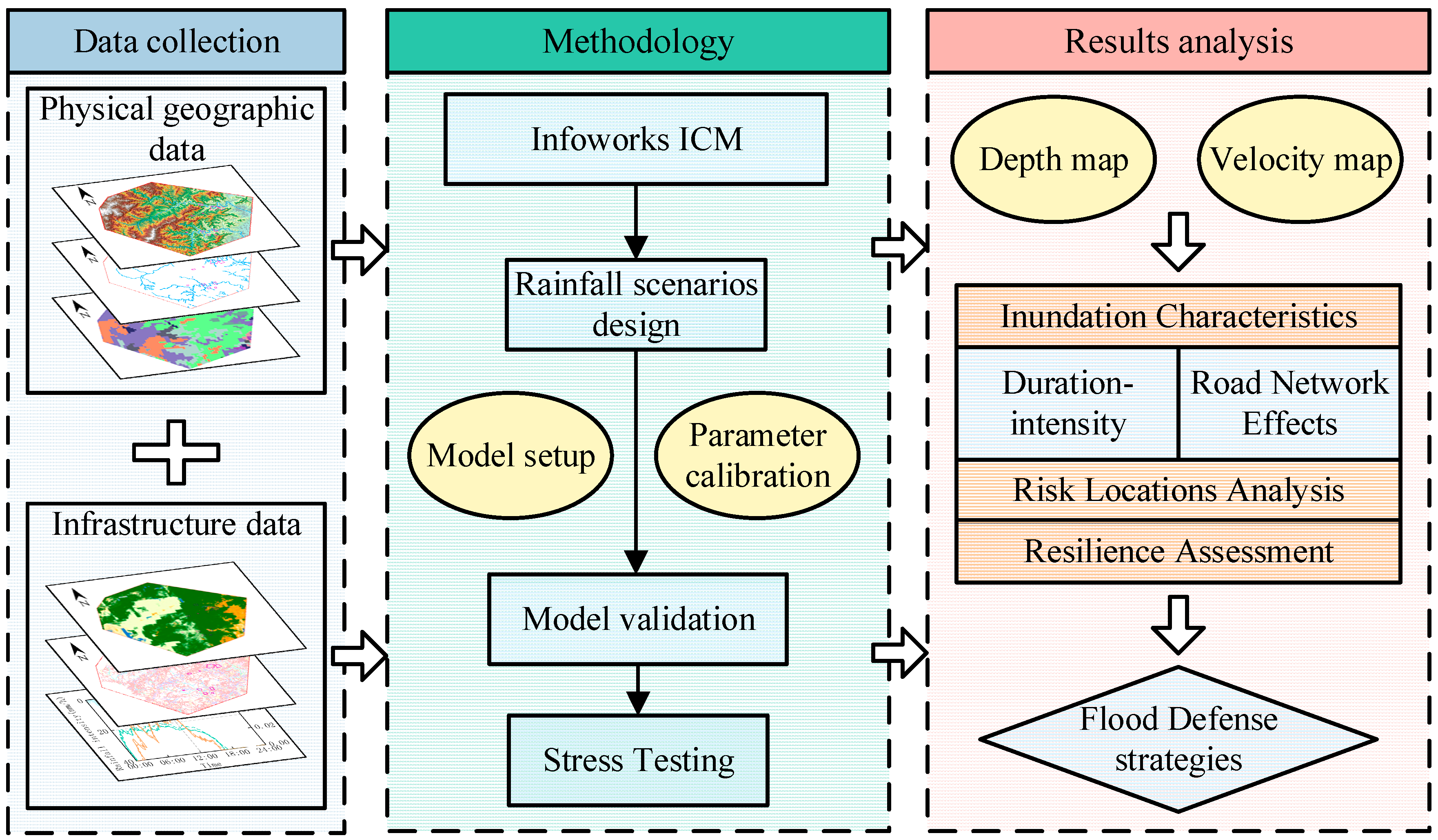



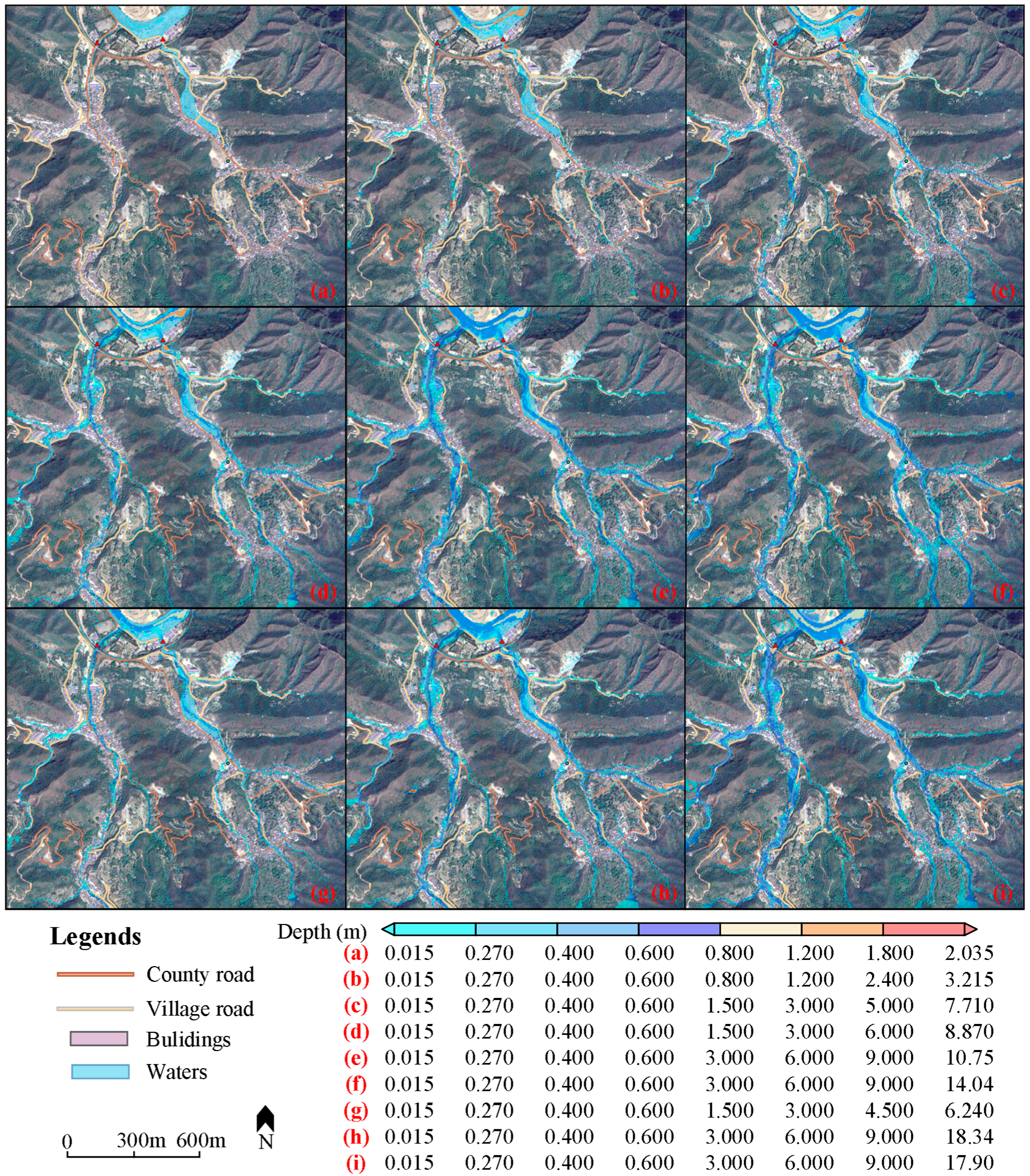
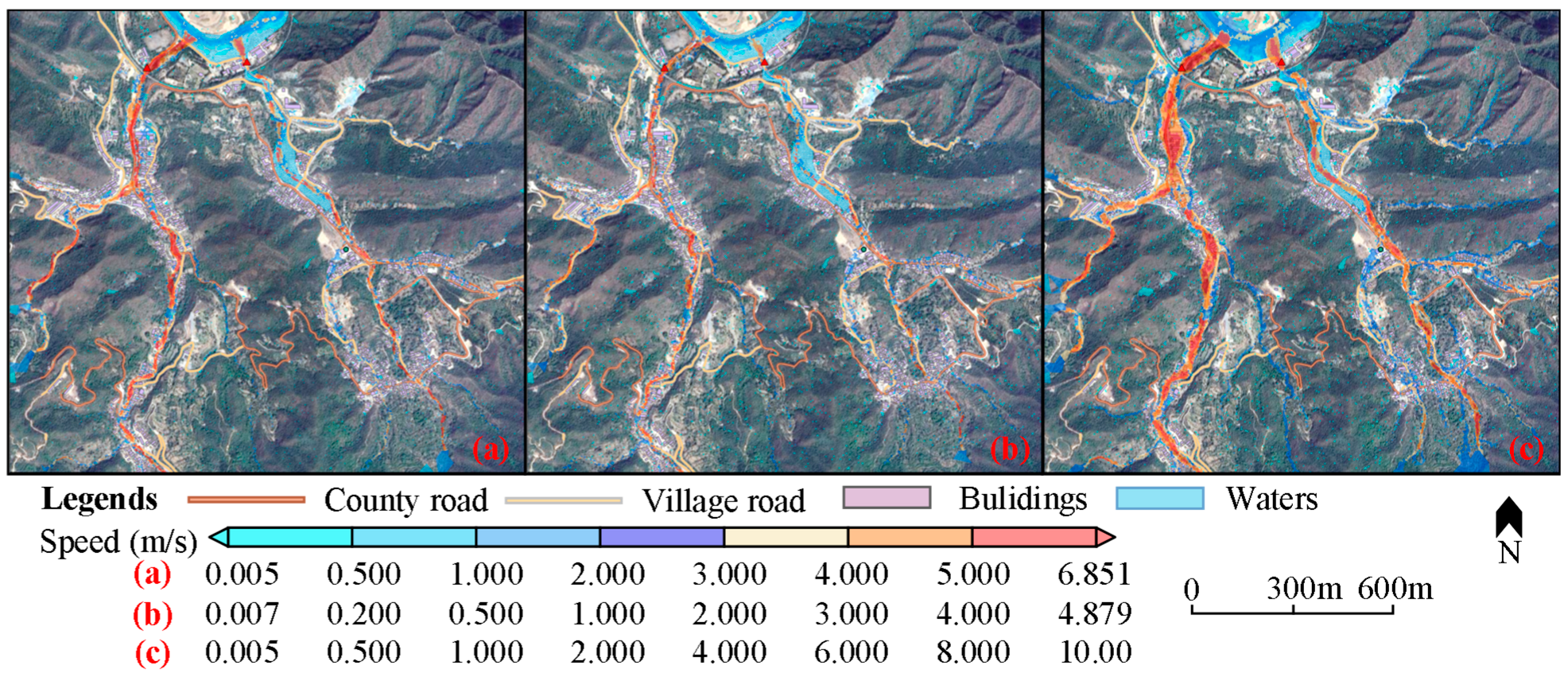


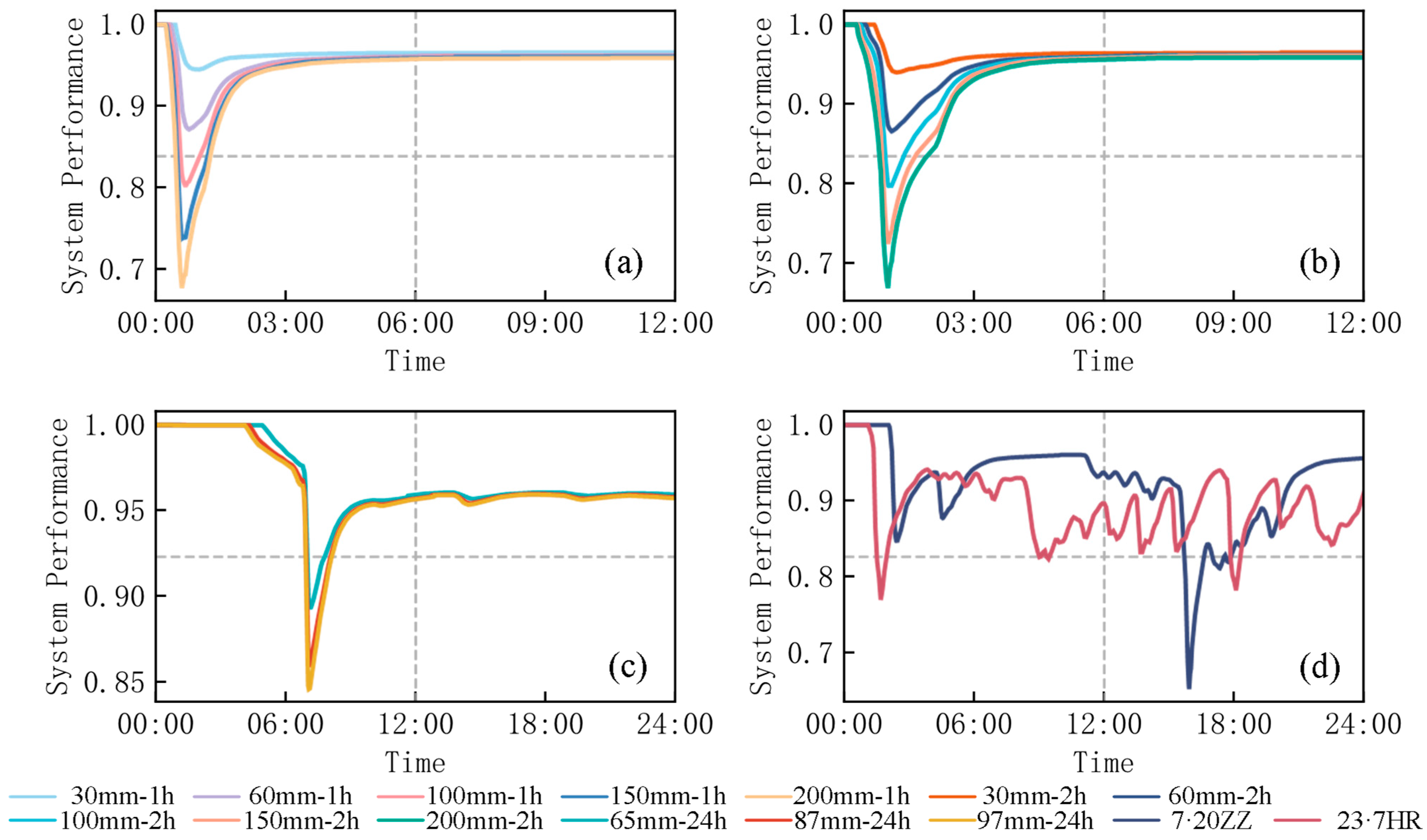
| Model | Dimensionality | 2D Rainfall Coupling | Primary Application | Advantages | Disadvantages | Computational Efficiency |
|---|---|---|---|---|---|---|
| SWAT | Conceptual | No | Watershed management | Large-scale simulation, long-term analysis | Limited urban flood detail | High |
| SWMM | 1D | No | Urban drainage | Robust pipe network simulation | Limited surface flow representation | High |
| HEC-RAS | 1D/2D | No | River and floodplain | Excellent river hydraulics, widely validated | No direct rainfall coupling | Medium |
| MIKE FLOOD | 1D/2D | Yes | Integrated flood modeling | Multi-scenario capability, comprehensive | High data requirements, technical expertise | Low |
| TUFLOW | 2D/3D | No | Integrated flood modeling | High-resolution surface flow | Limited 1D network coupling | Medium |
| InfoWorks ICM | 1D/2D | Yes | Integrated flood modeling | Multi-system integration simulation | Complex scene calculation time consumption | High |
| Type of Data | Data | Used for | Data Source |
|---|---|---|---|
| Physical geographic data | DEM | Flood simulation | ALOS [36]; Beijing Municipal Institute of Surveying and Mapping Design |
| Soil type data | Flood simulation | FAO and IIASA [37] | |
| River data | Flood simulation | Beijing Municipal Institute of Surveying and Mapping Design | |
| Land use data | Flood simulation | SinoLC-1 [38] | |
| Rainfall data | Model validation | Field measurement (KantianTech KT-WLM01/KTS-04-P) | |
| Water depth data | Model validation | Field measurement (KantianTech KT-SPOT2-BD) | |
| Infrastructure data | Building height | DEM correction | 3D-GloBFP [39] |
| Road data | Flood simulation | Beijing Municipal Institute of Surveying and Mapping Design |
| Date | Location | Simulated Water Depth (m) | Measured Water Depth (m) | Error in Maximum Water Depth (m) | Relative Error (%) | RMSE (m) | NSE |
|---|---|---|---|---|---|---|---|
| 0826 | point NO. 17 | 0.041 | 0.044 | 0.003 | 6.8 | 0.0030 | 0.9525 |
| point NO. 19 | 0.052 | 0.057 | 0.005 | 8.8 | 0.0038 | 0.9596 | |
| 0907 | point NO. 17 | 0.033 | 0.037 | 0.004 | 10.8 | 0.0020 | 0.9708 |
| point NO. 19 | 0.021 | 0.023 | 0.002 | 7.7 | 0.0017 | 0.9123 | |
| Pai fang | 4.61 | 4.56 | 0.06 | 1.1 | \ | \ | |
| 7·23 HR | point NO. 19 | 6.36 | 7.6 | 1.24 | 16.3 | \ | \ |
| Qiaodun | 4.29 | 5.3 | 1.01 | 19.1 | \ | \ |
| Land Surface Type | Fixed Runoff Coefficient | Roughness (Manning’s Factor) | Type of Infiltration | Initial Loss (mm) | Horton’s Initial Percolation Rate (mm/hr) | Horton’s Permeability Rate (mm/hr) | Horton’s Decay Rate (mm/hr) |
|---|---|---|---|---|---|---|---|
| roads | \ | 0.05 | Horton | 2.0 | \ | \ | \ |
| constructions | \ | 0.08 | Horton | 1.5 | \ | \ | \ |
| vegetation | \ | 0.15 | Horton | 6.0 | 76 | 20 | 2.28 |
| other | 0.35 | 0.05 | Fixed | \ | \ | \ |
| Rainfall Scenarios | 1 | 2 | 3 | 4 | ||||
|---|---|---|---|---|---|---|---|---|
| Maximum Depth (m) | Duration (min) | Maximum Depth (m) | Duration (min) | Maximum Depth (m) | Duration (min) | Maximum Depth (m) | Duration (min) | |
| 30 mm, 1 h | 0.022 | 0 | 0.401 | 680 | 0.006 | 0 | 0.001 | 0 |
| 60 mm, 1 h | 0.486 | 60 | 1.131 | 685 | 0.294 | 45 | 0.052 | 0 |
| 100 mm, 1 h | 1.174 | 80 | 1.347 | 690 | 0.617 | 65 | 0.437 | 35 |
| 150 mm, 1 h | 1.661 | 90 | 1.415 | 695 | 0.869 | 70 | 0.951 | 45 |
| 200 mm, 1 h | 2.026 | 95 | 1.329 | 695 | 0.947 | 80 | 1.325 | 55 |
| 30 mm, 2 h | 0.031 | 0 | 0.425 | 660 | 0.013 | 0 | 0.001 | 0 |
| 60 mm, 2 h | 0.534 | 75 | 1.158 | 670 | 0.306 | 60 | 0.067 | 0 |
| 100 mm, 2 h | 1.198 | 105 | 1.343 | 680 | 0.629 | 85 | 0.46 | 35 |
| 150 mm, 2 h | 1.683 | 120 | 1.407 | 685 | 0.87 | 100 | 0.971 | 55 |
| 200 mm, 2 h | 2.032 | 125 | 1.443 | 690 | 0.88 | 115 | 1.372 | 70 |
| 65 mm, 10 y, 24 h | 0.152 | 5 | 0.701 | 1065 | 0.156 | 5 | 0.001 | 0 |
| 87 mm, 50 y, 24 h | 0.5 | 65 | 1.143 | 1100 | 0.299 | 55 | 0.054 | 0 |
| 97 mm, 100 y, 24 h | 0.645 | 70 | 1.227 | 1115 | 0.355 | 60 | 0.117 | 0 |
| 7·20 ZZ | 2.105 | 425 | 1.422 | 1305 | 0.902 | 380 | 1.421 | 155 |
| 23·7 HR | 1.361 | 855 | 1.368 | 1355 | 0.699 | 760 | 0.637 | 130 |
Disclaimer/Publisher’s Note: The statements, opinions and data contained in all publications are solely those of the individual author(s) and contributor(s) and not of MDPI and/or the editor(s). MDPI and/or the editor(s) disclaim responsibility for any injury to people or property resulting from any ideas, methods, instructions or products referred to in the content. |
© 2025 by the authors. Licensee MDPI, Basel, Switzerland. This article is an open access article distributed under the terms and conditions of the Creative Commons Attribution (CC BY) license (https://creativecommons.org/licenses/by/4.0/).
Share and Cite
Yin, M.; Huang, H.; Yu, F.; Wu, A.; Tao, Y.; Sun, X. Study on Stress Testing and the Evaluation of Flood Resilience in Mountain Communities. Sustainability 2025, 17, 7463. https://doi.org/10.3390/su17167463
Yin M, Huang H, Yu F, Wu A, Tao Y, Sun X. Study on Stress Testing and the Evaluation of Flood Resilience in Mountain Communities. Sustainability. 2025; 17(16):7463. https://doi.org/10.3390/su17167463
Chicago/Turabian StyleYin, Mingjun, Hong Huang, Fucai Yu, Aizhi Wu, Yingchun Tao, and Xiaoxiao Sun. 2025. "Study on Stress Testing and the Evaluation of Flood Resilience in Mountain Communities" Sustainability 17, no. 16: 7463. https://doi.org/10.3390/su17167463
APA StyleYin, M., Huang, H., Yu, F., Wu, A., Tao, Y., & Sun, X. (2025). Study on Stress Testing and the Evaluation of Flood Resilience in Mountain Communities. Sustainability, 17(16), 7463. https://doi.org/10.3390/su17167463





